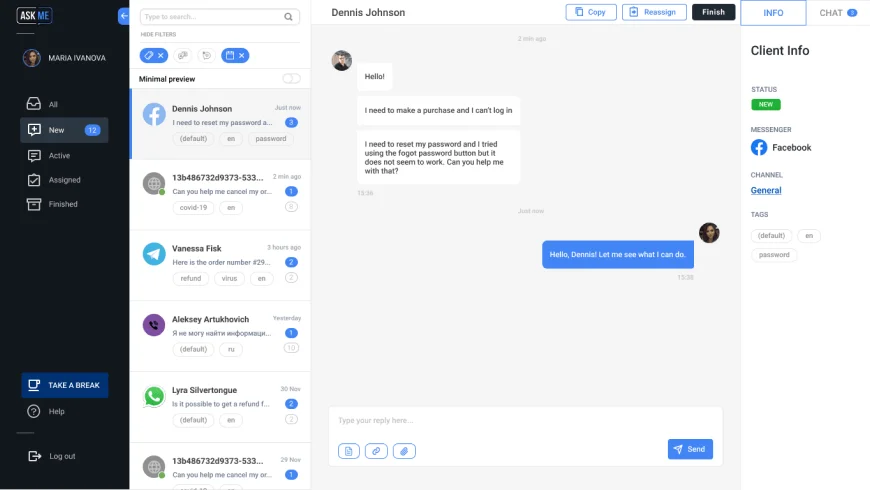Per our survey, 79% of customer service professionals say AI/automation tools are important to their overall strategy. Leveraging AI helps service professionals be more productive, offer round-the-clock support, and deepen relationships with customers. An AI-powered analytics tool can reduce your reaction time, summarizing what your conversations are about far faster than any human could. For example, it might pick up on a product issue before your agents are able to recognize it’s a problem, or it might recognize that products from a certain factory are more likely to have manufacturing issues. Customer service leaders have known for ages that chat support is usually a cheaper and more efficient way to provide support. Even better, many customers prefer live chat over support channels like phone or email.
- CMV was further examined in Smart PLS using the inner collinearity assessment function.
- The survey concludes that better conversations lead to greater customer satisfaction and loyalty, and a competitive advantage.
- Moving ahead into a more automated future can create the impression that the human touch — whether in everyday life or customer service — won’t be as valuable as it has been in the past.
- In 2016, Starbucks changed their rewards system from a visits-based program to a spend-based program.
- In summary, by examining the effect of relationship commitment on AI-enabled customer experiences, our study responds to recent calls to examine this effect in smart digital environments (Foroudi et al., 2018).
- Get in touch with us to explore how we can help you leverage AI in the social media industry and transform your business.
It is also a fundamental element for the success of automated services as it describes the relationship between humans and automation (Hengstler, Enkel, & Duelli, 2016). Wang et al. (2019) highlight privacy as a key component of trust, given that consumers aim to maintain a degree of control over the use of their data by retailers. In addition, previous studies have shown that trust can alter the relations between different factors in the context of AI use such as service quality and convenience (Siau & Wang, 2018; Ferrario, Loi, & &Viganò, 2019). AI technologies supported by data analytics are increasingly embraced by companies as a response to sustained margin pressures, shorter strategy cycles, and increased expectations from customers.
Subscribe to our Artificial Intelligence E-Alert.
It’s used most often to provide consumers with 24/7 support through chatbots, but people are also remaining vigilant over potential errors in generative AI and monitoring how it’ll impact the workforce. An AI-powered chatbot can be an ideal solution for delivering personalized and instant support. AI chatbots allow you to provide basic customer support 24/7, and when they’re plugged into your other support tools, they enable automation and personalization at scale. Over 70% of customers think that customer support agents should work together so customers don’t have to repeat information. We all know what it’s like to really need a problem fixed and to have to explain it over and over until you get to the person who can help you.

In fact, AI can transform the user interface as it can control all content of the interface design including visual elements, typography, animations and graphical information (Irfan, 2020). The application of artificial intelligence (AI) in the customer market has completely changed customer behaviors. This study aims to investigate the customers' co-creation experiences with AI in the digital age.
The perils and promise of AI customer engagement
For instance, TikTok employs AI-based facial recognition and image analysis to identify users who apply excessive and unnatural filters to their videos. The magic of artificial intelligence (AI) infrastructure such as large language models (LLMs) is its ability to generate text that mirrors human conversation, but that ability isn’t magic it’s the... The difference between typical customer support centers and AI customer support is best understood if you imagine the experience of a new support agent. Companies using AI for customer service should turn to it to optimize customer service – not to completely eliminate humans from the equation. KFC is a great example of a brand that uses AI to offer a personalized shopping experience.
It works side by side with your agent, helping them to quickly adjust the tone or length of a message. We’re explaining this not to discourage the use of AI in your customer service organization, but to be clear about what AI is and isn’t capable of doing. And while ChatGPT can sound very human, it’s not able to process and use information in the way that we humans do. The product's at the forefront of AI, leveraging Large Language Models and tweaking them based on your customers' conversation history.
Effect of the foot-in-the-door technique on user compliance
Agents may be so focused on increasing the speed of their responses, they never get a moment to become more knowledgeable about your organization. In the event they do gain that knowledge, it comes from a lengthy onboarding which can prove fruitless if the agent underperforms or chooses to pursue another opportunity. This not only reduces the number of calls in the queue, but it also creates a seamless customer experience. Customers will simple requests are engaged with immediately, while those with more complex issues are met with a human response. And, if the AI can’t resolve the issue, it can redirect the call to a service agent who can.

As a result, there is a lack of research on how customers perceive AI technology as part of their shopping experience, and how this leads to a more pleasant experience and stronger relationships with brands (Shank et al., 2019; Wang, Molina & Sunder, 2020). This paper provides several avenues for future research focusing on the design of anthropomorphic information agents and may help in improving the interaction of AI-based CAs through user compliance and feedback. For example, we demonstrate the importance of anthropomorphism and the perception of social presence to trigger social bias as well as the need to stay consistent to increase user compliance. Moreover, with the rise of AI and other technological advances, intelligent CAs will become even more important in the future and will further influence user experiences in, for example, decision-makings, onboarding journeys, and technology adoptions. The use of bots as customer service agents capable of handling many tasks is revolutionizing the relationships between companies and their clients.
Preparing for the digital customer experience: Setting priorities to turbo-charge digital transformation
AI can be used to run social media contests and giveaways more efficiently and effectively. AI can be used to protect user privacy by encrypting data and developing new technologies that preserve privacy. It’s even more frustrating when it’s a simple question or task, like paying a bill or checking a balance. what is AI customer service These tasks can now be handled by an AI system that responds to numbers and audio prompts. Customers simply tell the AI what they want to accomplish and the bot completes the request. This will leave more time to focus on strategic or creative activities that can’t be performed by robots (at least not yet).

Traditional chatbots are no-code tools that interact with visitors based on rules-based or keyword-based decision trees. The AI of today is powered by machine learning and natural language processing and understanding that works to understand the sentiment and intent of incoming support tickets. Despite these changes and advances, some might say that there are still disadvantages to utilizing AI within customer service. AI is being used in almost every facet of business to improve processes and create efficiencies. With the power of artificial intelligence, businesses across a wide range of industries have seen positive growth and change for their employees and their customers across all areas of business, but most specifically in customer service and the customer experience.
Check out our solutions
This finding is further supported by the fact that social presence mediates the effect of ADCs on user compliance in our study. Thus, when CAs can meet such needs with more human-like qualities, users may generally be more willing (consciously or unconsciously) to conform with or adapt to the recommendations and requests given by the CAs. However, we did not find support that social presence moderates the effect of FITD on user compliance. This indicates that effectiveness of the FITD can be attributed to the user’s desire for self-consistency and is not directly affected by the user’s perception of social presence. This finding is particularly interesting because prior studies have suggested that the technique’s effectiveness heavily depends on the kind of requester, which could indicate that the perceived social presence of the requester is equally important (Burger 1999).
SupportGPT™ from Forethought.ai is the world's first generative AI platform specifically for customer support. Alexakis emphasizes that "we've learned to ask our customers what they prefer and help them accordingly. In case of routine queries, we use AI, but in case of detailed queries or complaints, we ensure to use a human CS Rep." "The AI was not able to directly fix any data issues with our application or provide any low-level support, meaning that it was only useful for basic initial queries," says Farmer. For example, "Some elderly individuals may feel uncomfortable or unfamiliar interacting with AI-powered systems, preferring human interaction and reassurance."
Regulatory Compliance
Platforms like AspireIQ use AI to match brands with influencers whose audience demographics align with the campaign’s target market. Before you automate everything, remember there are certain situations that should be dealt with by humans. There are a lot of emotions involved, and while AI can efficiently tackle simple queries, it’s unable to show empathy. This gives human assistants more time to deal with issues that call for in-person attention or to answer questions that are too complex for AI to answer.
AI can make a chatbot seem more human
Perceived sacrifice mediates the effects of convenience, personalisation, and AI-enabled service quality on AI-enabled customer experience. Previous studies acknowledge that technical and functional service quality affect the way customers evaluate brands (Chiou & Droge, 2006; Eisingerich & Bell, 2008). In the absence of other information, the type of technology and the way it is implemented by a service provider may act as a proxy into their character from a consumer perspective and help consumers establish an initial level of trust. Morganosky (1986, p. 37) defines service convenience as “the ability to accomplish a task in the shortest amount of time with the least expenditure of human energy”. Convenience leads to higher engagement (Roy, Balaji, Sadeque, Nguyen, & Melewar, 2017; Van Doorn et al., 2010).
HubSpot's Content Assistant
In a broad sense, it responds to recent calls for research in the area of consumer interaction with cutting-edge technologies including AI (Ameen, Tarhini, Shah, & Hosany, 2020). In terms of the theoretical contributions, the research is one of the pioneering studies to advance knowledge on customers’ views of AI-enabled customer experiences, our research contributes to a better understanding of human interaction with AI-enabled services. By highlighting the role of trust and perceived sacrifice, our proposed conceptual model contributes to a better understanding of AI-enabled customer experiences. The findings of this study provide guidance for retailers aiming to provide AI-enabled customer experiences. Additionally, chatbots can transfer a caller to a customer service agent if a human is needed in the loop.